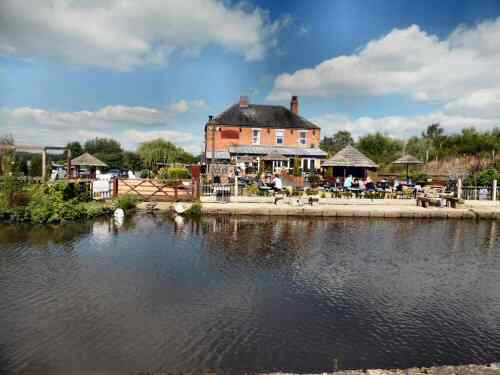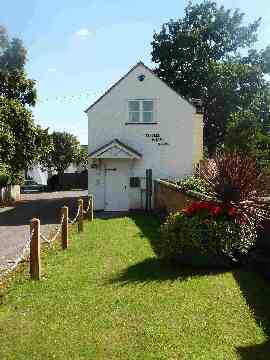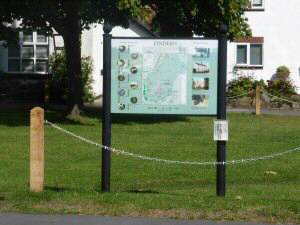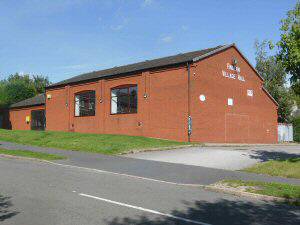FINDERN

INFORMATION
Where is it? –The village is located just off the A38, south of Littleover, in South Derbyshire (SK308304).
What to do? – Visit Dobbies Garden Centre which holds a wide range of plants, garden furniture and other items. In addition, there is a spacious café/ restaurant and a small enclosed children’s play area. – Stroll around Mercia Marina, browse the shops, and explore the sensory garden and wildlife walks. – Enjoy a walk along the canal bank. Where there is plenty of activity on the water in the peak season and wildlife all year round. – Visit Repton which was the capital of the Kingdom of Mercia in the 7th century. St Wystan’s Church has existed at Repton, in some form or other, since the 8th century. Underneath the chancel is a Saxon crypt that was the burial place of Mercian kings.
Where to eat? – The Dragon, previously known as the Green Dragon at Willington. It has been substantially refurbished and provides seating both inside and out facing the canal – Willow Tree Café at Mercia Marina, where you can sit and enjoy good food and the view across the marina.
Other places to visit
Melbourne is set amongst pleasant rolling countryside in South Derbyshire. It has a wealth of historic buildings. A famous country house with formal gardens, one of the finest Norman churches in the country, and a lovely 20-acre pool. Where you can feed the ducks, or just rest awhile and admire the scenery. – Calke Abbey, ‘The place where time stood still’ was the phrase used to describe it. When the National Trust opened it to the public in 1989. It is one of the most unusual English country houses with extensive collections of birds, ornaments, paintings and photographs.


PROFILE
The pretty South Derbyshire village of Findern is situated five miles to the southwest of Derby. Its appearance is enhanced by a traditional village green with chestnut trees. Encircled by white posts and chains and overlooked by the church and picturesque, mainly whitewashed cottages.
The Green
Before the Parish Council took action in the 1950s to restore the green. It looked like a sorry sight divided into four small grassed areas, split up by tarmac paths and frequently used by vehicles. The main problem was in knowing who owned the green. Eventually, ownership was traced to the Crown and the land was purchased for £50 and the restoration started.
A village sign has been erected on the green to mark the Millennium and, more recently, a village map added. During 2006, the neglected Parish Rooms were transformed and together with the village hall now provide much-needed facilities for what is a very active community.

Development
Findern Footpaths Group has improved over seven miles of public rights of way around the village. In addition to keeping the footpaths clear and the stiles in good repair, they have planted trees and wildflowers. Helped create a new wood and been involved in several other projects. These include Ballast Hole Pond, near the Trent and Mersey Canal, where a pond dipping platform has been installed. As well as the erection of bat and bird boxes.
The village was mentioned in the Domesday Book when it was held by Burton Abbey as an outlier of Mickleover. A priory once stood near the church. Where the monks were supplied with fresh food from the fishponds on Common Piece Lane. Following the dissolution of the abbey, the Fynderne family became the principal landowners. They lived in a fortified manor house on Castle Hill.
Before the development of transport, the village was self-supporting. It was here, in 1740, that Jedediah Strutt came as an apprentice wheelwright. He had an obsessive interest in machinery. However, when his uncle died and left him a smallholding, he took it over. Returning to Findern to marry Elizabeth Woollatt who lived at the Old Hall, where he had previously lodged. Later he went on to become a famous industrialist. He set up mills and employed large numbers of people at Belper and Milford. Now an integral part of the Derwent Valley Mills World Heritage Corridor.
Silk weaving used to be a popular local industry with nearly every cottage having its loom. In addition, velvet-making is known to have taken place at the 17th-century Ivy Cottage. One of the oldest surviving properties in the village. The front garden of which was once used as a pinfold, to enclose stray animals.
The Mill
Local farmers took their grain to the miller to be ground. One such miller was Joe Lovatt, a somewhat unusual character and a staunch Methodist. Once he had accumulated sufficient money from milling, like his predecessor John Wesley. He set off on horseback to preach around the villages in Derbyshire. When his money ran out he returned to milling.
The mill was converted into a private house, in 1914. Edwina Currie lived there in the 1980s when she was MP for South Derbyshire. It is claimed that it is possible to see 22 churches from the mill’s elevated position.

Religion
All Saints’ Church was rebuilt and consecrated in 1863, on the site of a Saxon place of worship. A Norman tympanum was rescued when the old building was demolished and can be seen in the church. Reg Parnell, the famous motor racing driver, is buried in the churchyard. He kept a herd of 700 pigs and 150 Ayrshire cattle at the farm next to Wallfield House.
Lower Green, or Bumpton as it is known locally, is the home of the Methodist Chapel. It was opened in 1835 with a tea party, which has become an annual tradition. There is a well at the front and a garden, both of which were renovated in 1984 by the Brownies. Consequently, they won the National Aid Cherish Conservation Competition for their initiative and hard work.
Findern also had an early 18th-century Unitarian Chapel. This was built just over five miles from Derby. At that time the law decreed that no Dissenting Meeting House should be built less than that distance from the town. It was demolished in 1939.
The Presbyterians had an academy in Doles Lane, where higher education of a good standard was provided. Because it was not available to dissenters through universities. Dr Ebenezer Latham, principal of the academy lived at The Longlands. After serving as a hotel for several years, the property has been divided up for multiple occupations.
The Village
Several old farms in the village are no longer used for that purpose. On the corner of Bakeacre Lane, Spring Farm’s name came from the well in the yard. Further up Doles Lane, Willow Farm was a working farm until 1990. Tucked away behind the green is Corner House, an early 18th-century farmhouse. The window is blocked up to avoid paying window tax.
Somerville House on Main Street, with its high gateway to allow carriages entry, was built in the mid-18th century. Longlands Farm supplied the land for the car park at the former Wheel Public House, now undertakers. The village school on Heath Lane is separated from the main village by the new A50. On the same road, but on the opposite side of the canal, the Nadee Indian Restaurant replaced the Greyhound pub.



